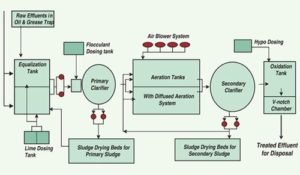Effluent Treatment Plant:
- Integ Group has hands-on experiencee with a wide range of industrial effluents.
- Treatments schemes for critical effluents like distillery spent wash,Pharmaceutical color effluent,Sludge effluents, and textile & leather effluents are some areas of expertise.
- It s also a leading solution provider in engineering effluent treatment.
- Our strength is it’s through know-how of anaerobic & aerobic methods of treatment.
- Industrial effluent treatment plant-design,Specification,Installation and Commissioning of New effluent treatment plants.
- Industrial effluent treatment plant-assessment,Comprehensive study of existing.
- Treatment System,Re-establish the existing effluent treatment plants.
Plant Diagram:
Effluent Treatment Plant:
Advantages:
- Stay in compliance with regulations for releasing waste water.
- Pay less cost for supplying water through recovery of production materials from the waste water.
- These reduces hauling and offsite treatment prices.
- This also reduces extra water usage.




